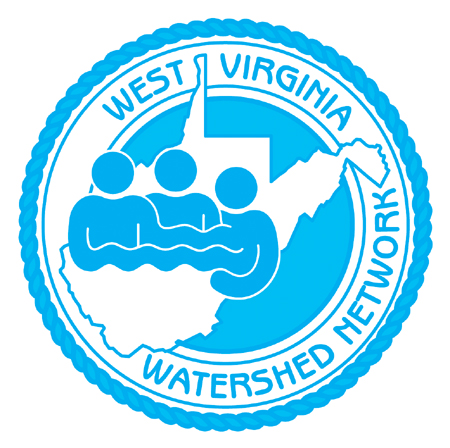 | | WV WaterNet: Winter/Spring 2024 |
| | WVDEP Programs Collaborate to offer Educators a Water Monitoring Workshop By: Tomi Bergstrom & Callie Cronin Sams |
| 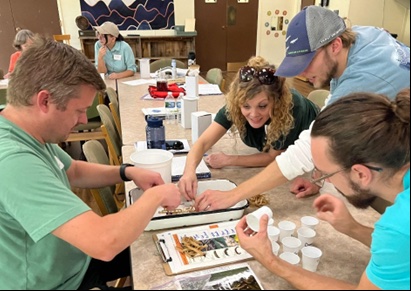 | Educators learn about Project WET and the WV Save Our Streams program. |
|
|
| Two educational programs hosted within the WV Department of Environmental Protection’s Watershed Improvement Branch tested out the waters with a new workshop, Water Monitoring Workshop for Educators in the summer of 2024. Project WET (Water Education Today) offers various water-focused workshops for Pre-kindergarten through college level and has a mission to advance water education to understand global challenges and inspire local solutions. West Virginia Save Our Streams conducts workshops to train volunteers on how to monitor their local wadeable streams and rivers. This allows the program to meet its mission of preservation and restoration of our state’s waters by providing an understanding of their ecological integrity. This special topic workshop focused on those who educate students (upper elementary through college level) or the public about water monitoring. It was free to attend, and all types of educators (formal and informal) were welcome to attend. The workshop featured the Project WET Healthy Water, Healthy People curriculum guide, and an opportunity to gain WV Save Our Stream Level 1 certification and monitoring kits. The activities featured in the guide were hands-on and interdisciplinary and complemented the methods taught within the Save Our Streams volunteer monitoring program. Educators attending the workshop learned why we monitor water and safety concerns. They also conducted a chemistry, habitat, and macroinvertebrate assessment on Waddles Run and scored the stream according to biotic indices. In the afternoon, they dived into Project WET activities that were linked to standards and highlighted the importance of being both precise and accurate when collecting data, how data can tell a story of a stream’s health and other activities that allow educators to raise awareness and understanding of water quality topics and issues by demonstrating the relationship of water quality to personal, public, and environmental health. Educators who attended reported on how the collaboration of the programs made the program feel more complete from both doing the science and then also reinforcing that experience. To learn more about Project WET or Save our Streams, contact the program coordinators: |
| Tomi Bergstrom (She/Her)
WV Department of Environmental Protection
DWWM - Watershed Improvement Branch
601 57th Street SE,
Charleston, WV 25304
Phone: (304) 926-0499 x43862
Email: Tomi.M.Bergstrom@wv.gov |
|
|
Callie Cronin Sams (She/Her)
WV Department of Environmental Protection
DWWM - Watershed Improvement Branch
47 School Street, Suite 301
Philippi, WV 26416
Phone: (304) 314-6095
Email: Callie.C.Sams@wv.gov |
|
|
| | Long-Term Advocate for Flatwater Paddling and Restoration of the Coal River Set to Retire By: Tomi Bergstrom |
| 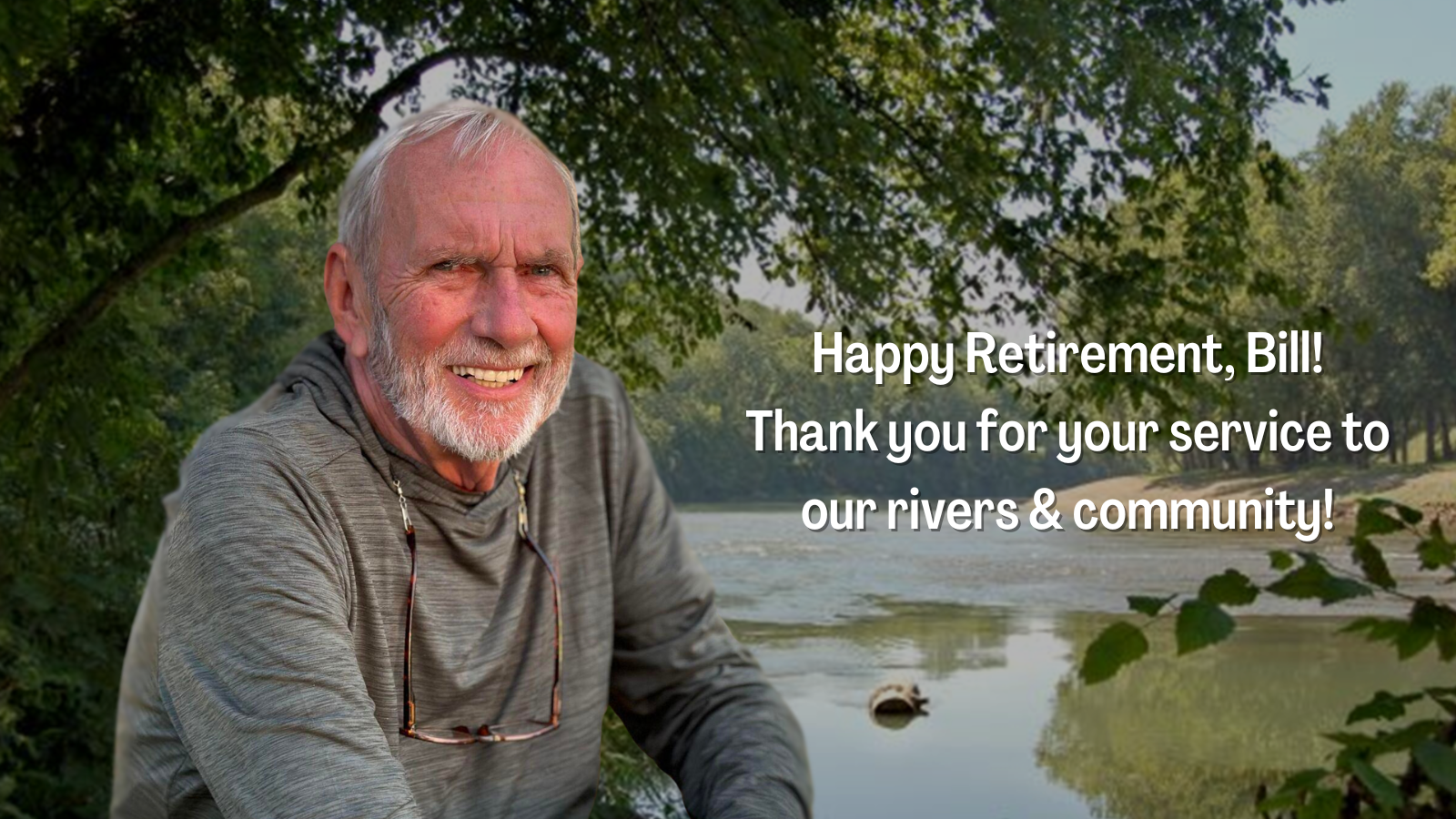 | Bill Currey, in front of the serene Coal River. |
| If you have been following the flatwater trail movement in West Virginia, then you know Bill Currey. Bill has dedicated over 24 years of service to promoting recreation on, protection of, and cleaning up the Coal River watershed. June 15, 2024 marked the 20th anniversary of the Tour de Coal, a major fundraising event for the Coal River Group that has grown from a small group of 44 paddlers to a booming 2,300 paddlers on the river. When talking with Bill Currey about his upcoming retirement, he’ll say, “My early plan for restoration of the river is what I’m most proud of.” Bill had a vision early on, and with the help of over 600 volunteers, support from state agencies including the WV Department of Environmental Protection (WVDEP) and WV Division of Natural Resources (WVDNR), many grants, and a lot of persistence, he has shown how a grassroots organization can become a major community leader and advocate for clean water. Bill basically went on tour promoting the Coal River Group’s work, saying, “Guys, we’re not here to protest; we’re here to fix things. What can you do to help us?” Coal River Group utilizes multiple social media platforms to share success stories, upcoming events, and volunteering opportunities. Bill has united a diverse and rural community around the Coal River watershed. We hope that, like us, you find inspiration from an action like that. To learn more about Bill Currey’s upcoming retirement, check out these three linked articles: |
|
|
| | Acid Rain has Decreased in West Virginia By: Martin Christ |
| 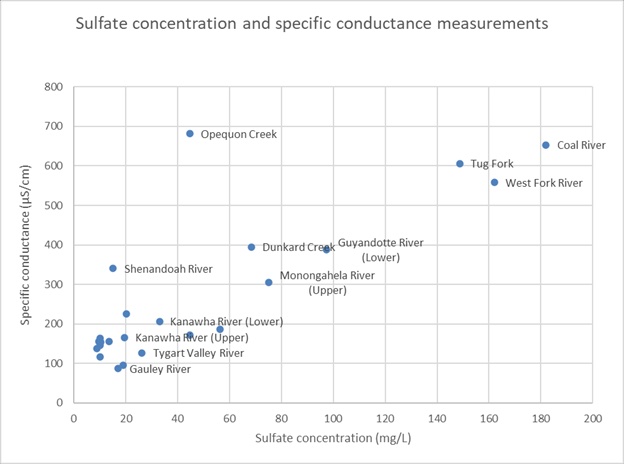 | | If you do a lot of water quality monitoring, you may have poked a conductivity meter into a few streams, and you may have observed a very wide range of results. Some waters have conductivities in the low double digits, and some are in the thousands. The sulfate concentration plays a role in which range they wind up in (Figure 1). Sulfate in the streams with the highest conductivities probably comes from disturbed ground, especially mining, but a small amount comes from acid rain. Rainwater data over the last decades indicate that acid rain has decreased substantially. |
| 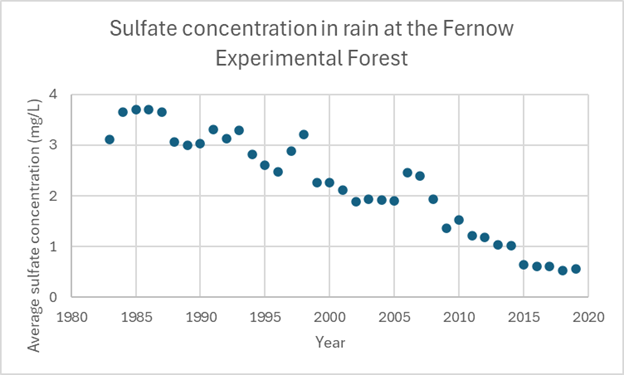 | Figure 2: Annual average sulfate concentration of rain samples collected at the Fernow Experimental Forest near Parsons, WV. (USFS Research Data Archive) |
| At some point in the 20th Century, people started burning more and more fossil fuels for energy, which added sulfur compounds to the air. Those compounds traveled with the winds and eventually came down as sulfuric acid in the rain. Sulfuric acid contains sulfate. No one tracked the exact trajectory of when acid rain started to increase and when it peaked, but there is a good record of sulfate concentrations in rainwater as sulfate concentrations have decreased (Figure 2). The record is from the Fernow Experimental Forest near Parsons. Since 1987, the sulfate concentration in rain has decreased from almost 4 mg/L to less than 1 mg/L. Similar data from the Hubbard Brook Experimental Forest in New Hampshire indicates that sulfate concentrations in rain were already high in the 1960s and confirms a decrease to less than 1 mg/L since the late ‘80s. Not all the sulfate deposition is in rain. Some of it comes down as particles, and some arrive as gas or aerosol particles that stick to surfaces, such as leaves. The total flux of sulfate deposition, wet plus dry, has been tracked over recent decades. This animation illustrates that sulfate deposition has decreased even if dry deposition is counted. Pollution controls at power plants account for the decrease. As water moves through forests and soils, the amount of sulfate goes up because much of the water evaporates or is taken up by plants and released back into the air. Still, the contribution of sulfate from rain is small compared to the amounts in some of West Virginia’s rivers. Although the contribution of sulfate from rain was small compared to that of mining, fish kills and declines in some fish populations were attributed to acid rain, especially in mountainous areas without much calcium in the bedrock and soils. Fish communities in such places in West Virginia should be benefitting from the decline in sulfate deposition. |
| | Voice of the Future By Jessica Bryzek, Northern Basin AmeriCorps VISTA |
| 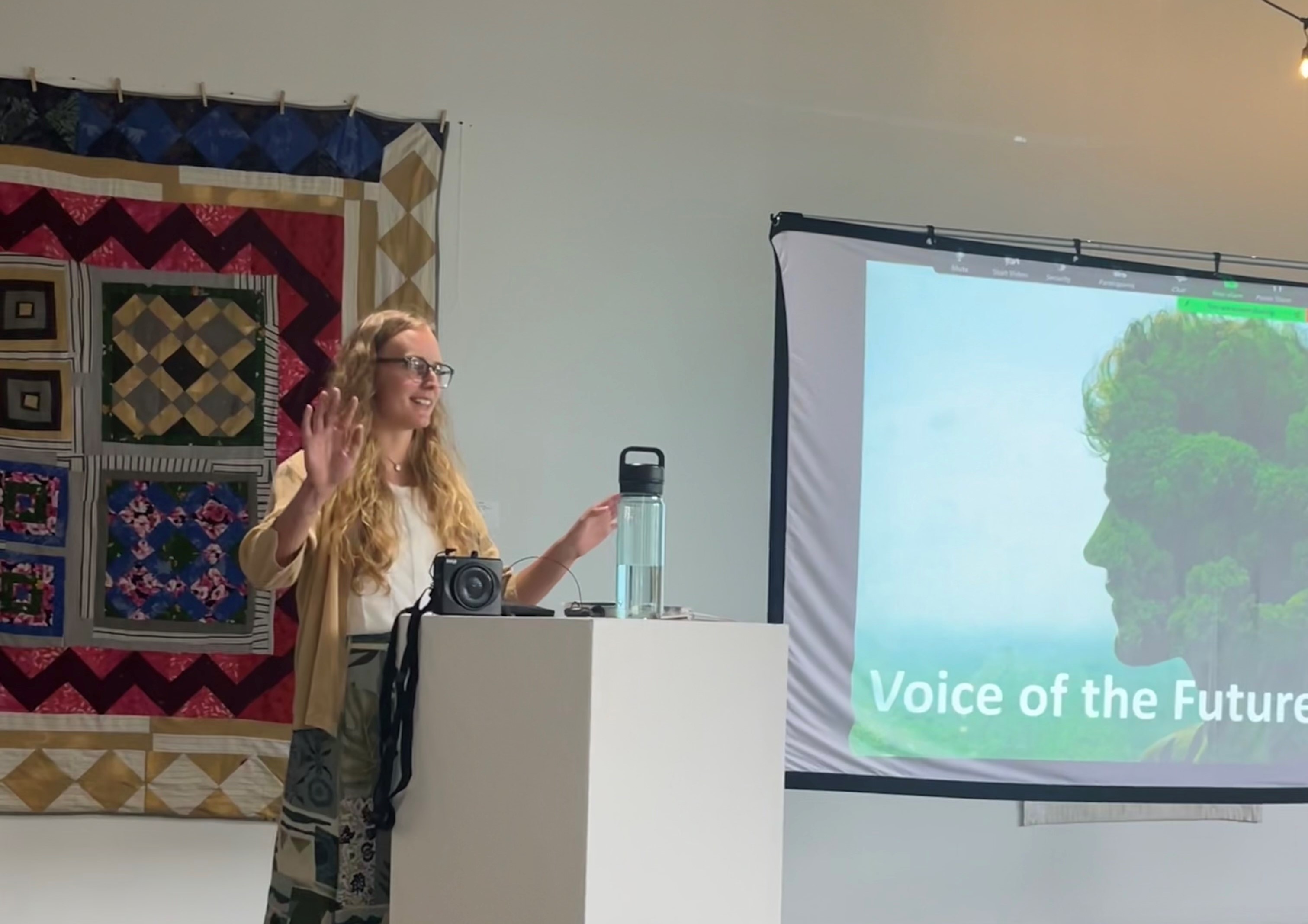 | Jessica speaking at the Spring Confluence. |
| In June, watershed groups from the Upper Ohio basin gathered together at the Spring Confluence. I was invited to participate and share my perspective as a “youth” working in the environmental field. A short recap of my talk is below. I wonder if you remember the childlike curiosity of being in nature as a kid? And I wonder when was the last time you allowed yourself to embrace this feeling as an adult? To freely explore the more-than-human world with no purpose and no agenda? For me, nature has always been a source of inspiration, a place for recreation, and a refuge to escape the chaos of our busy modern lives. Over my life, my relationship with nature has really expanded. I’ve come to realize that nature doesn’t just exist “out there”, but nature is present inside each of us. Each time we take a breath, drink, or eat, we are ingesting the environment, and the outside world literally becomes in. In my current role as an AmeriCorps VISTA, I work closely with the Buckhannon River Watershed Association to build capacity, which includes presenting new ideas, building new partnerships, and expanding the identity of the group to attract new volunteers. Although the group formed in 2001, the past year has been a turning point. The board is working to combat the “doing things just because we’ve always done them” mindset and confronting existential questions: Who are we? What do we represent? We’ve initiated a strategic planning project, expanded our science and restoration work to encompass recreation and prioritized community engagement. One of the many things I’ve learned through this role is that ecological restoration is really community revitalization. I’ve observed how each individual of the group is motivated, passionate, and selfless. BRWA believes that they are there to improve the water and serve the general community, but also that the watershed group is a community itself. A watershed group is a community of folks who don’t need to be convinced that the environment is important. Each time I hear the extent and intensity of the environmental destruction and harm humans are causing, I feel overwhelmed and heartbroken, and I feel the tightening in my chest. The concept of empowerment is what motivates me to be involved in environmental work. Empowerment is a process of enabling individuals to connect their actions with outcomes. Empowerment reaches beyond education. While heightened awareness of environmental issues and their implications can initiate new patterns of behavior, environmental education is just the beginning of promoting attitude and behavioral change and is really more of a critical thinking skill than a subject. One way we can support empowerment is through genuine listening. I invite you to take a deep breath, go outside, remember your childlike call to explore nature and listen to the story that nature is weaving. |
|
|
| | Watershed Group Spotlights: Read below about some of the new watershed groups making a splash in West Virginia! |
| Town Run Watershed Association By: Kristen Bisom |
| 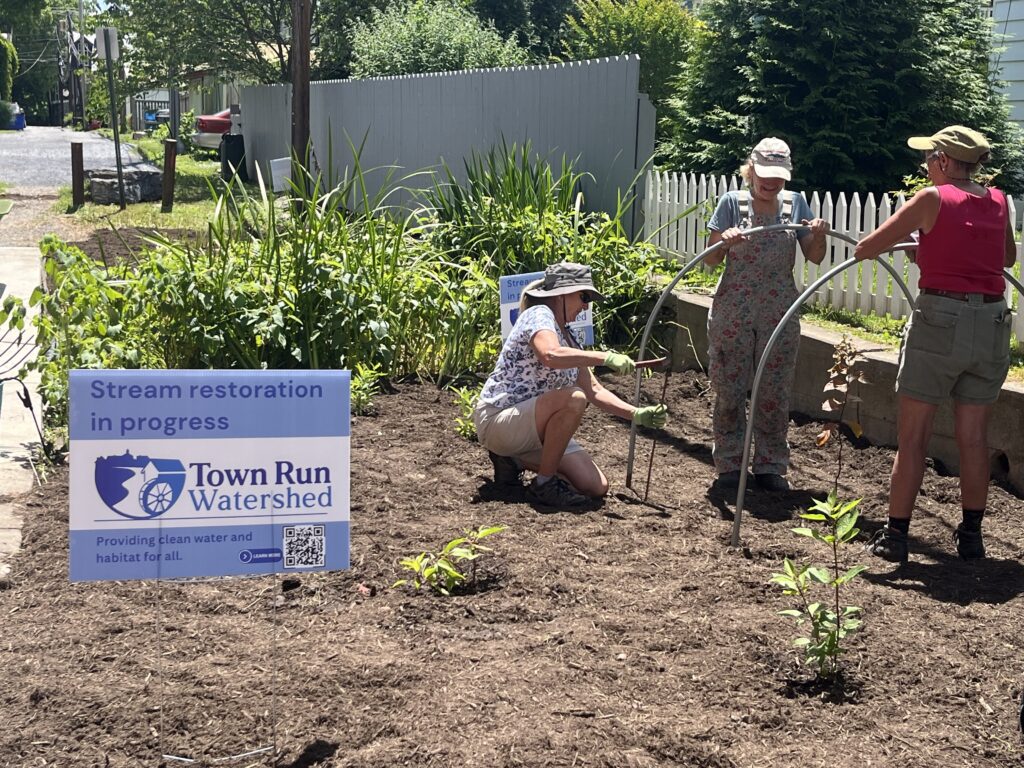 | Town Run Watershed volunteers planting native plants after removing invasives next to the creek. |
| The Town Run Watershed Association (TRWA) has made a big impact in their small community since forming in early 2023. Located in Jefferson County, WV, the Town Run is a small spring-fed creek that flows through the historic town of Shepherdstown before emptying into the Potomac River. Threats to the health of the creek include new development, aging septic systems, and stormwater runoff from within town limits. Initial water quality monitoring results have shown high bacteria levels in the creek. Attempts by some stakeholders to form a Town Run group during COVID set the stage for community members to form a permanent group in 2023 when they learned that the Shepherdstown Water Department planned to start using the Town Run as a drinking water source for the town, blended with water from the Potomac River. Another factor was the impending construction of a housing development adjacent to the Town Run and within the creek’s source water protection area. Since revitalizing the group, the TRWA steering committee has met monthly, and a larger stakeholder group has met quarterly. Members of the group come from a wide variety of professional backgrounds as well as state and local agencies, nonprofits, and the Shepherdstown government. Organizers consider the diversity of members’ skills and interests one of the group’s greatest strengths. The TRWA applied for a Stream Partners grant soon after forming. They have been using the grant to remove invasive species from the Town Run’s streambed and riparian corridor one section at a time, which has visibly improved the creek already. They’ve hosted outreach events and are planning for projects such as installing informational signs where major roads cross into the watershed. The TRWA has also been busy conducting water quality monitoring, organizing a septic system workshop, and analyzing tree canopies and springs within the watershed. In the future, they hope to increase tree canopy, mark the town’s storm drains, complete restoration projects, and educate as many watershed residents as possible. The community has reacted positively to the group’s efforts. Numerous volunteers have shown up to help remove invasives, and more than 50 people attended a presentation hosted by the TRWA on the history of the Town Run. The group created a website where many residents have signed up to be a “Friend” and have made donations. TRWA organizer Kay Schultz is proud of how many people throughout the watershed now take ownership of the creek. The next steps for outreach include connecting with more families and young people, as well as Shepherd University, religious communities, and the local homeschooling network. When asked for recommendations for others trying to start similar groups, Schultz and founding member Greg Welter suggested that organizers recognize the gifts that different people can bring to your group, cultivate as many partnerships as possible, and get to know your stream and the history of the area. Learn more about the Town Run Watershed Association on their website: https://townrunwatershed.org/ |
| Twelvepole Rising - A New Watershed Association in Wayne, West Virginia By: Kate Cruickshank, Western Basin AmeriCorps VISTA |
| 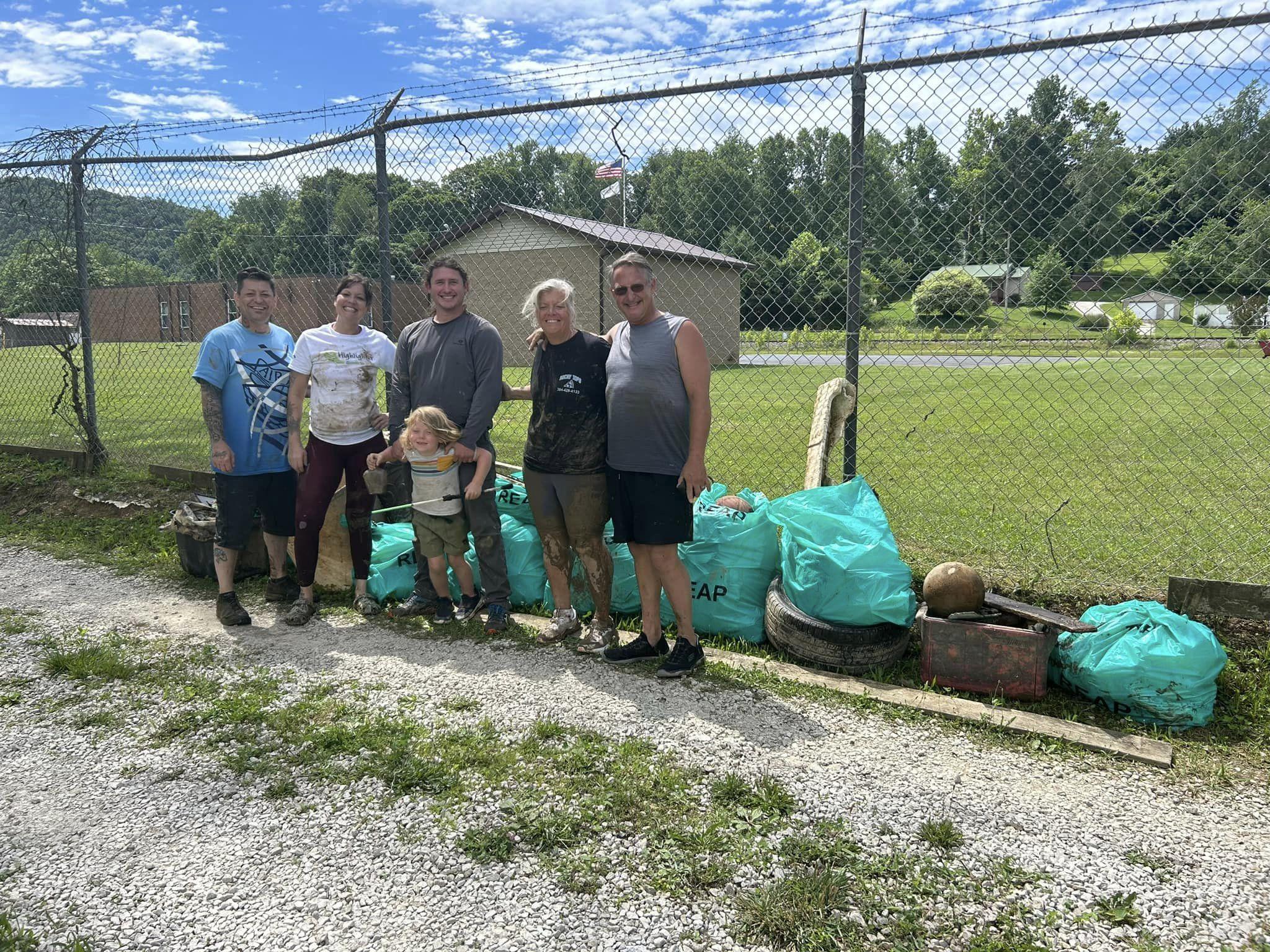 | | Twelvepole Rising is one of the newest watershed associations in the state of West Virginia, located in the Town of Wayne. The Twelvepole Creek watershed runs through Lincoln, Wayne, Cabell, and Mingo counties. They are focused on water trail development and designation while promoting their local stream, Twelvepole Creek. They have hosted monthly kayak float events in their watershed, drawing participants from various backgrounds. The goal behind these events is to promote accessibility to the stream, get community members engaged and excited about the water trail, support and help to clean up the watershed, and to promote recreation. Every year in the summer, the Town of Wayne hosts Creek Fest, Twelvepole Creek Festival, which has vendors, crafts, a fishing tournament, and a kayak race. In preparation for this popular festival, Twelvepole Rising hosted a clean up of the stream, with seven community members volunteering their time and effort. This collaborative cleanup ensured that the creek was pristine and inviting for festival-goers. Unfortunately, Creek Fest was canceled shortly after due to other community events occurring at the same time. However, their efforts didn’t go unnoticed; the creek remained clean for an extended period of time after the clean up, positively impacting the environment. The West Virginia Department of Environmental Protection - Environment Matters produced a video about the clean-up. In the upcoming year, Twelvepole Rising hopes to get a portion of Twelvepole Creek designated as a West Virginia Water Trail. This designation would further enhance the community’s value and ownership for their local waterways. You can find more information about Twelvepole Rising and their upcoming events on their Twelvepole Creek Rising Facebook page! |
| | Summer 2024 Events Recap Summer is a busy time of year for many of our hardworking watershed groups! Read below about some of the amazing events put on by these groups this year. |
| 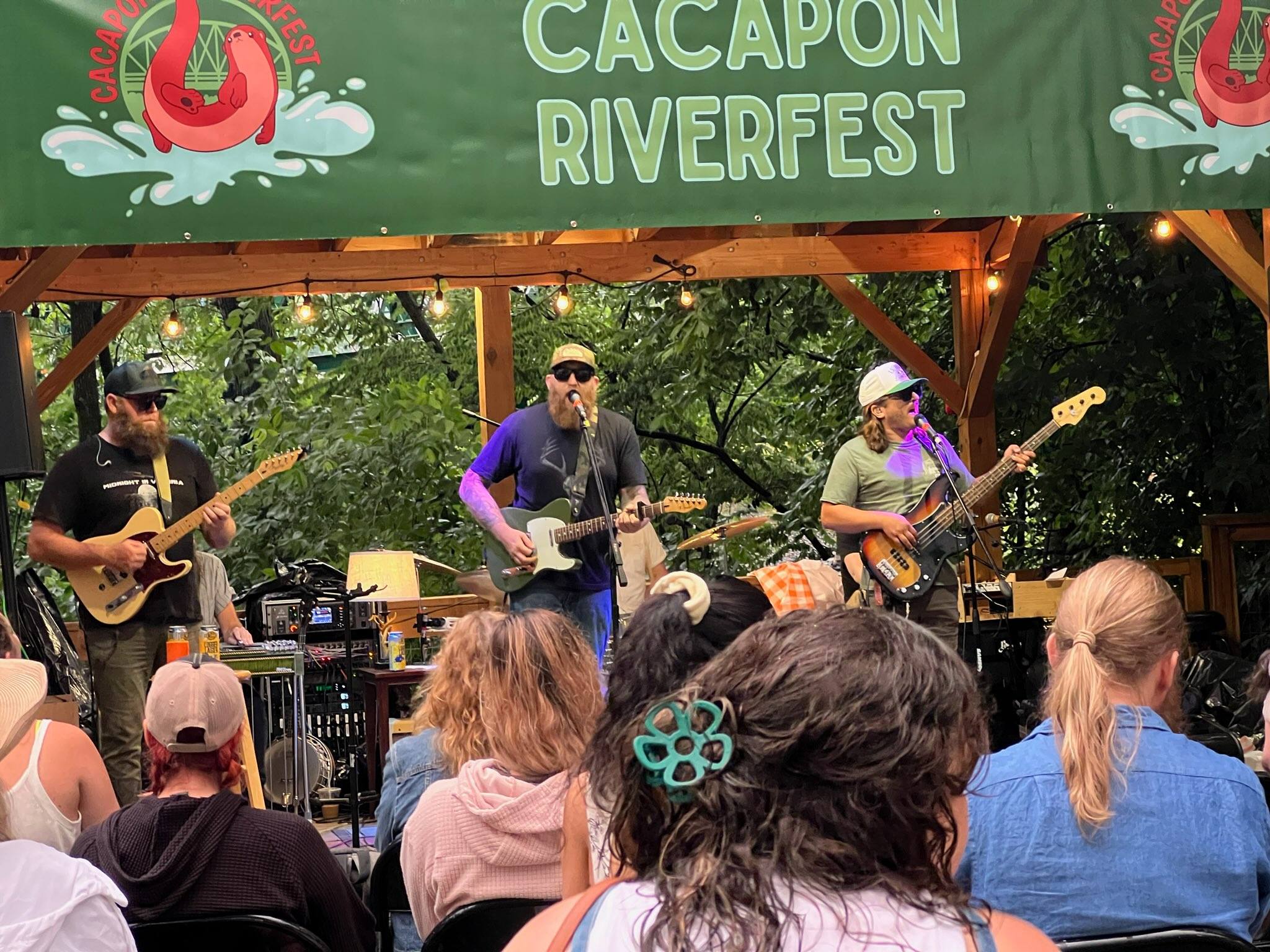 | A band performs at Cacapon Riverfest. |
|
|
Cacapon Riverfest Friends of the Cacapon River held their annual Cacapon Riverfest in June. This two-day celebration of the environment included live music, food trucks, art activities, presentations from environmental groups, and, of course, lots of river fun! Festival-goers enjoyed a rock skipping contest, fly fishing demonstration, boat race, and other activities on the river. |
|
|
| 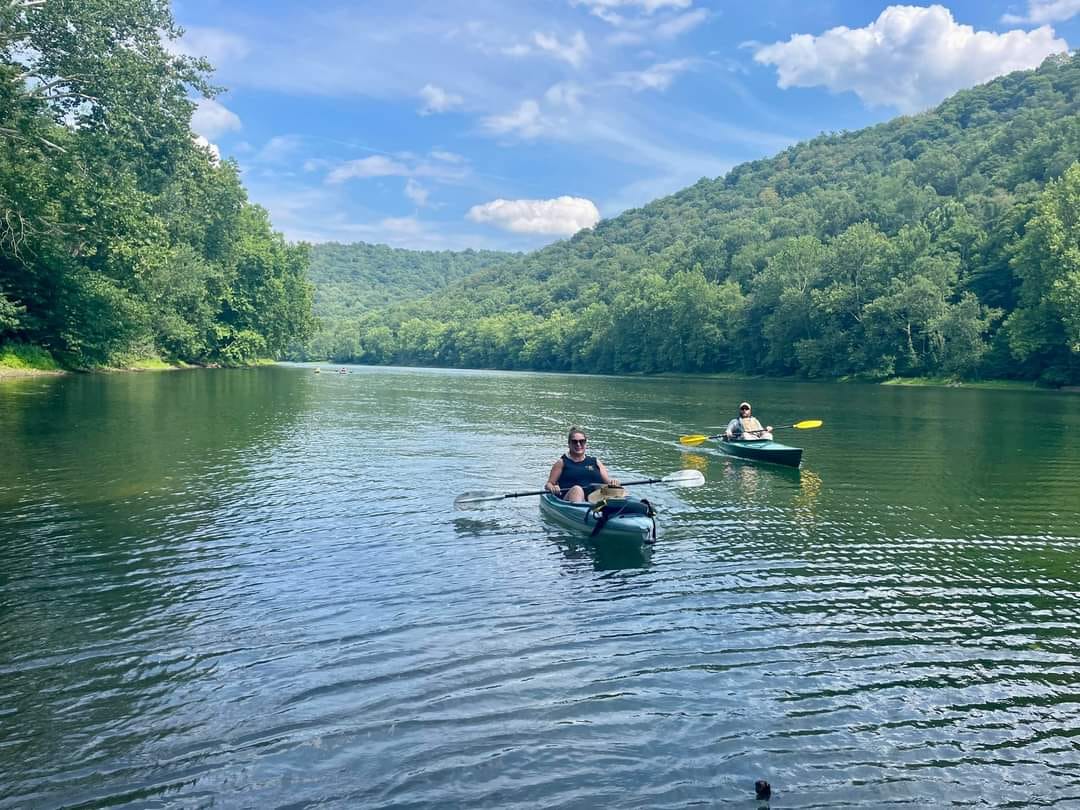 | Kayakers on the Tygart Valley River. |
|
|
Tygart Valley River Rally Save the Tygart hosted their annual Tygart Valley River Rally in July. Folks gathered for a two-day celebration to promote recreation and enjoyment of the riverway. The event started with an evening of live music, tubing, and learning from educational booths in Grafton. On Saturday, paddlers embarked on a scenic 9-mile paddle from Grafton City Park to Valley Falls State Park. Paddlers were all smiles after spending the day networking and enjoying the beauty of the river! |
|
|
| 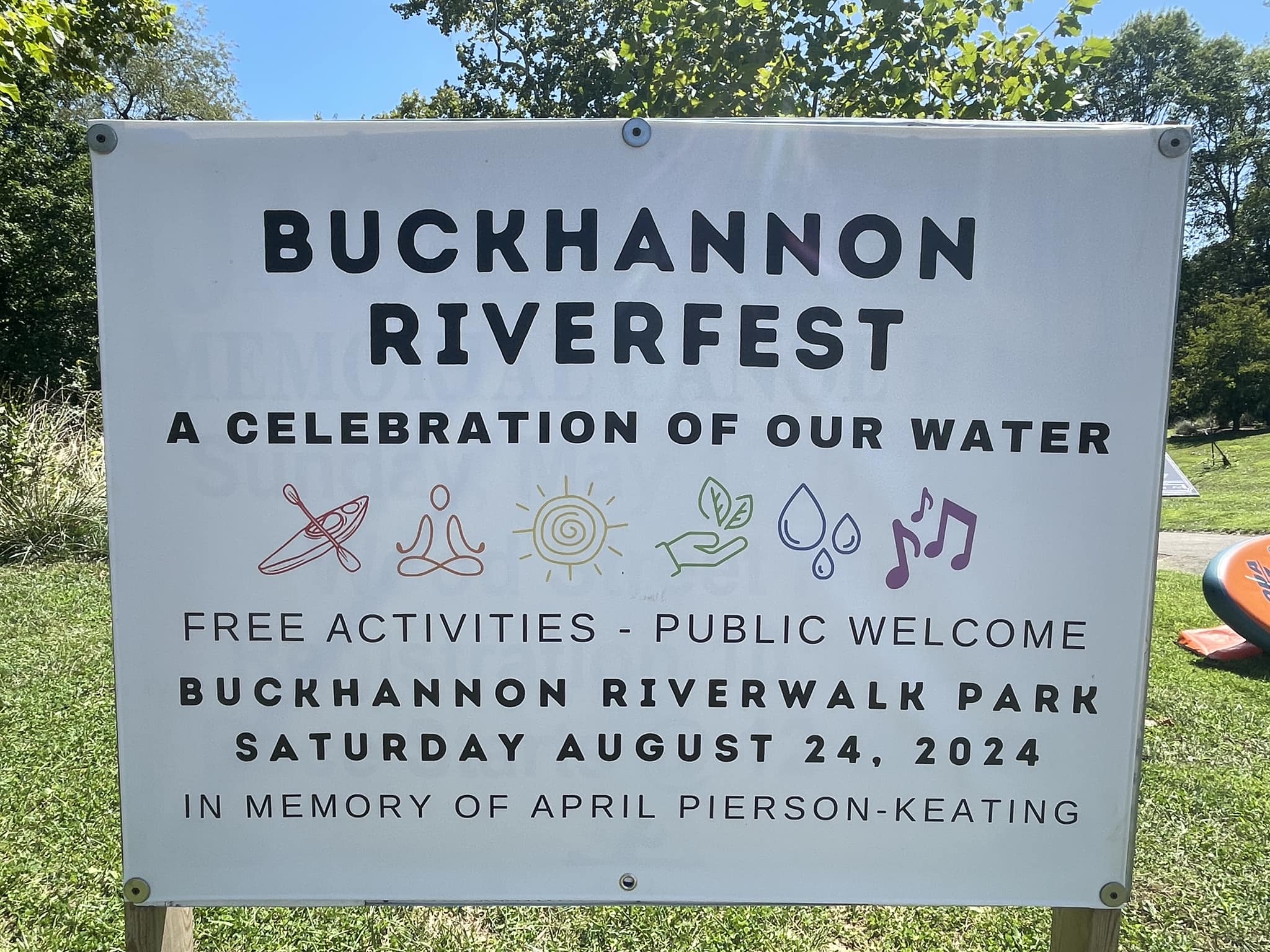 | A Sign for Buckhannon Riverfest remembering A |
|
|
Buckhannon RiverFest The Buckhannon River Watershed Association hosted the 8th annual Buckhannon RiverFest in August. Each year, the community gathers to celebrate our water and enjoys a day of free activities including a flatwater paddle, hands-on water educational activities, food, live music, comradery, and more! This year, we had over 150 people enjoy the festival. Approximately 30% of paddling participants were youth, and our youngest paddler was just 3 years old! About 70% of folks were first-time paddlers on the Buckhannon River! Bringing people together around our water is what motivates BRWA to protect and promote the Buckhannon River. |
|
|
| | | | 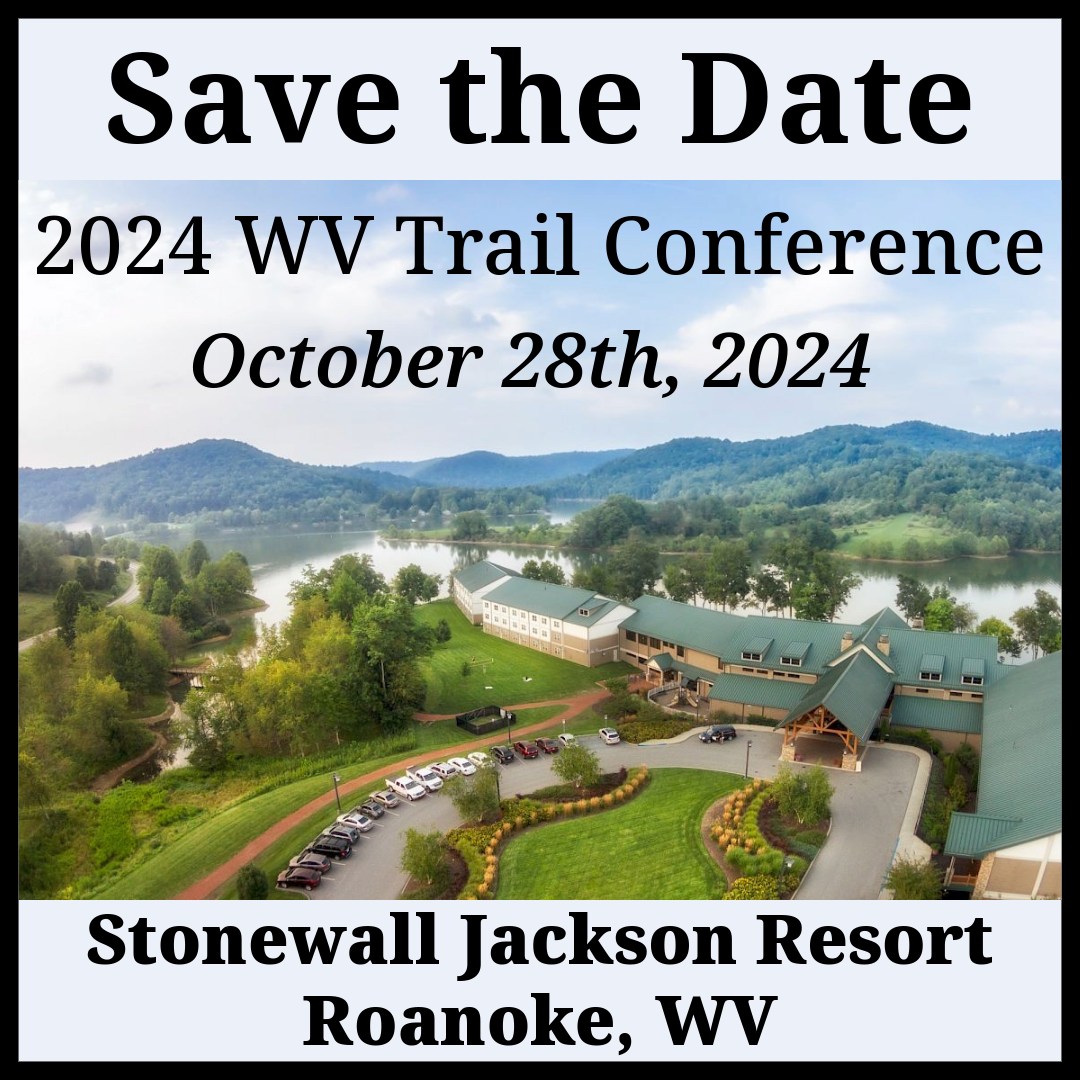 | Learn all about WV's non-motorized trails! Join WV TRAIL on October 28 for a full day about water, rail, and land trail funding, visioning, volunteerism, youth participation, legislative engagement, and all-things for trail enjoyment. Field trips and special programs are offered on Oct 27 and 29. Come for the day or for all three days and support nature-based, non-motorized recreation throughout the Mountain State! For more information and to register: https://www.wvtrail.org/registration#Details |
|
|
| 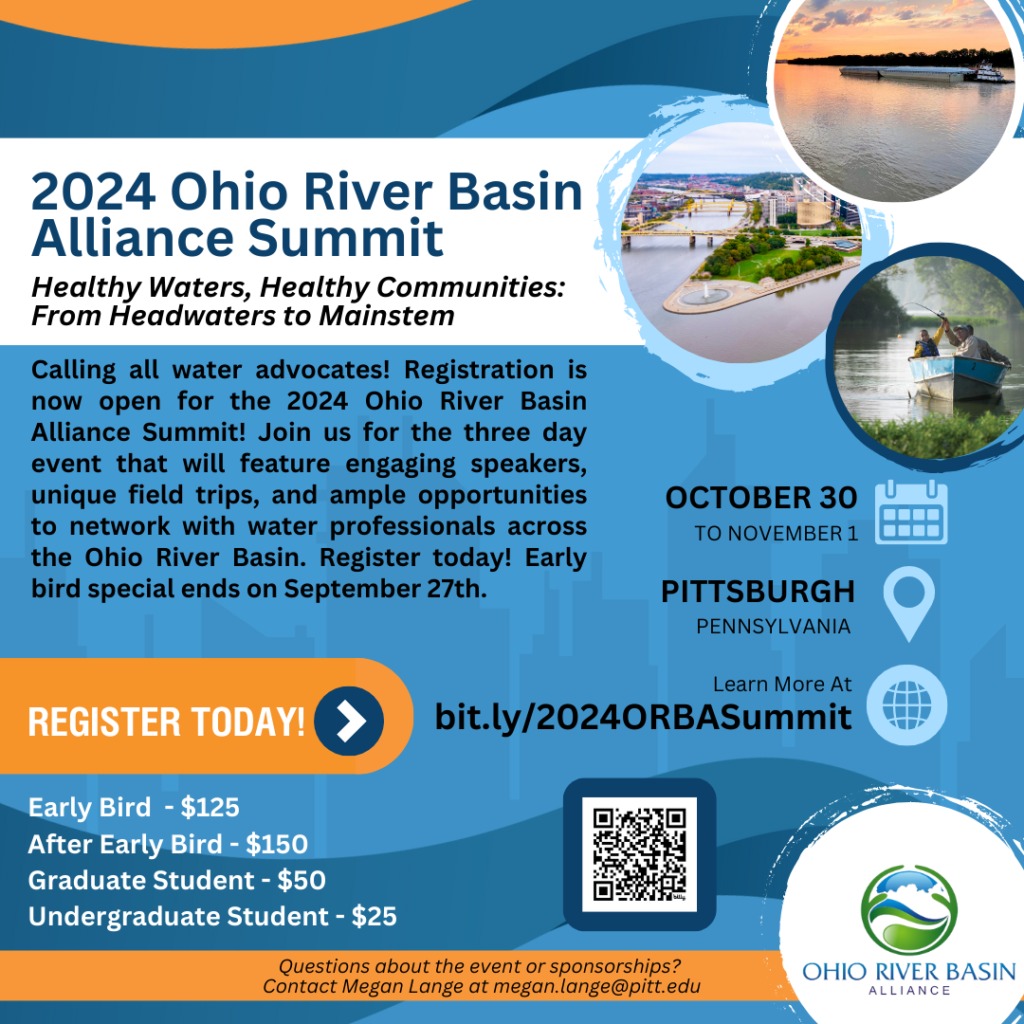 | Explore the Ohio River Basin's environmental future! Register to attend the Ohio River Basin Alliance (ORBA) Summit at the University of Pittsburgh from Oct 30 to Nov 1 for an engaging, in-person event featuring expert discussions on the critical environmental issues impacting the Ohio River Basin. This summit offers a platform for community members, stakeholders, and specialists to collaborate on sustainable solutions for the region's future. Register today: bit.ly/2024ORBASummit |
|
|
| | | | |
|
| | West Virginia Rivers Coalition
3501 MacCorkle Ave SE #129 | Charleston, West Virginia 25304
304-637-7201 | wvrivers@wvrivers.org |
| The WV WaterNet is made possible through an award of Environmental Protection Agency’s 319 funding awarded to the West Virginia Rivers Coalition by the West Virginia Department of Environmental Protection. |
|  | |
|
| |
|
|